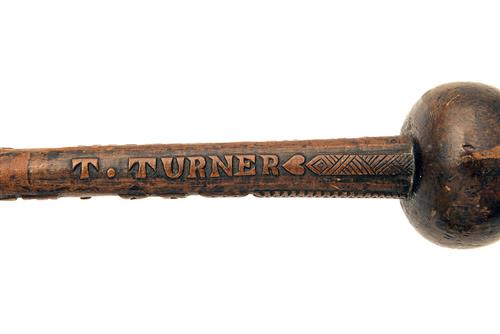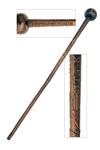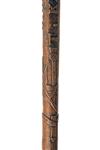Product Details
AN HISTORIC CARVED ZULU KNOBKERRIE,
recovered on March 29th 1879 at the Battle of Kambula by Private Thomas Turner of the 90th Perthshire Rifle Volunteers, 28in. overall with integral 2 1/2in. diameter bulbous head, the shaft carved variously 'T. TURNER', 'KAMBULA - MARCH', 'T. KEW' and with a Scottish thistle motif, geometric designs, a heart and a garter.
This item was subject to an feature in the September 2018 edition of Sporting Gun, to read the article please click HERE.
Other Notes: Kambula was the turning point of the Zulu wars. Taking place on March 29th 1879, it came straight after a number of defeats for the British Army, most notably the massacre at Isandlwana just two months earlier. Now the 2,086 men of Colonel Evelyn Ward's forces faced a Zulu regiment or 'Impi' of at least 20,000. Some of the British present had barely escaped with their lives from Hlobane the previous day, a battle which had seen 225 Officers and men killed and eight wounded for the loss of only a handful of Zulus. The British had also lost a significant number of valuable horses and supplies. The camp at Kambula was different though. Well prepared and with earthen and stone fortifications occupied by artillery as well as a 'laager' formed by tightly roped together wagons and a 'kraal' to contain the livestock, the odds of 10-1 did not seem insurmountable. The 90th occupied a small redoubt just north of the kraal.
The Zulu King Cetshwayo had responded to pleas from the abaQulasi for help fighting Wood's harassing troops a few days earlier by sending the whole Zulu army to their aid. However, Cetshwayo had ordered them not to attack the fortified defences at Kambula but instead try to draw the British troops out into the open. Luckily for the British, the impi chose to ignore these orders and formed up for the attack. At 12:45 pm the British took to their battle stations. The Zulus, in their typical 'buffalo head' formation attempted to outflank the positions with the right horn, staying out of artillery range until it halted north-west of the camp. The formation's left horn and the centre halted south of Kambula. Lieutenant-Colonel Redvers Henry Buller attempted to provoke an early attack by sending his mounted troops out to engage the tip of the right horn. Getting within range of their Martini Henry carbines, they fired and then immediately retreated back to the safety of the encampment, hotly pursued by 11,000 Zulus. As soon as the horsemen were safely back behind the lines the four 7pdr cannon of the artillery opened fire with explosive shell and canister shot inflicting heavy casualties on the Zulu. Some brave Zulu warriors actually made it through the firestorm and penetrated the wagon laager only to be despatched by the bayonets of the waiting troops. Eventually the accurate rifle fire and artillery halted the main Zulu advance and the right horn of the attack withdrew. As it did, the central block of Zulus and the left horn of the Impi surged up out of a ravine to the front of the camp. Vicious close range fighting took place and the Zulus managed to over-run the livestock Kraal. The present livestock hampered both sides, but the British managed to withdraw back only to give the occupying Zulu the ability to use the kraal walls as cover. The right horn saw their opportunity and resumed the attack, threatening the 90th in the redoubt and the guns of the artillery. Realising the situation was critical, Woods ordered the men of the 1/13 regiment from the laager to clear the ravine of Zulus. Two companies charged out across open ground led by Major Hackett, bayonets fixed and forced the Zulus back. The companies then formed line and poured a withering fire into the packed warriors. Suddenly the upper hand was lost and the troops found themselves under fire from previously hidden Zulu marksmen. Hackett sounded the retreat but was blinded by a shot as he went with his men. Encouraged by the sight of this withdrawal, the Zulus charged again but this time were cut down by a cross fire from the wagons and the redoubt as they were caught in the killing zone in front of the laager. Meanwhile the artillery were engaging the right horn having wheeled their guns out into the open and poured round after round into the faltering Zulu. Despite continually mounting attack after attack, by around 5pm the impetus had gone out of the courageous Zulu. The Kraal was cleared of warriors and the Zulu began to pull away eastwards. Wood at this point ordered Redvers Buller to mount his men up and pursue. The Zulus were harried without mercy for about seven miles, with the Abaqulasi being singled out for special attention after the defeat the day before at Hlobane. Cecil D'arcy of the Frontier Light Horse wrote at the time 'Buller was like a tiger drunk on blood' and 'we butchered the brutes (Zulus) all over the place'.
By the end of the battle over 750 Zulu lay dead in front of the British positions, but the cavalry pursuit accounted for untold more whose numbers were never counted. British dead numbered 29 with another 54 wounded. The whole incident caused a national outcry back in England due to the army's 'heavy handed' treatment of the Zulu during the pursuit, but the Army had achieved a considerable victory. Cetshwayo had lost many of his finest warriors and his hope of suing for peace was dashed. The superiority of modern weaponry against spear and shield was only too obvious. Never again would a Zulu Impi fight with the ferocity and tenacity that they had done up to this date.
Unfortunately not much more is known about Private Turner. We know he survived the whole of the Zulu campaign and was present when the 90th became the Cameronians a few years later. The remainder of his life is unfortunately lost to history. The name 'T. Kew' is also a mystery as no-one of that name was present at the battle and it is assumed that he or she was friend or relative who was gifted the knobkerrie
Please click HERE to view Terms & Conditions.
Estimate £300-500 € 333-555





